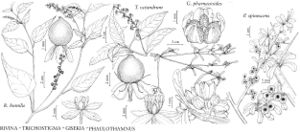FNA>Volume Importer |
FNA>Volume Importer |
| Line 13: |
Line 13: |
| | }}<!-- | | }}<!-- |
| | | | |
| − | --><span class="statement" id="st-d0_s0" data-properties="tree size"><b>Shrubs </b>or small trees.</span> <span class="statement" id="st-d0_s1" data-properties="branchlet architecture;thorn arrangement"><b>Branchlets </b>spinescent, sometimes with scattered thorns.</span> <span class="statement" id="st-d0_s2" data-properties="leaf arrangement;leaf architecture or arrangement;leaf architecture"><b>Leaves </b>alternate, sometimes fasciculate, exstipulate;</span> <span class="statement" id="st-d0_s3" data-properties="blade shape;blade shape;blade shape;blade shape;margin architecture or shape;margin architecture or shape">blade spatulate to oblanceolate to elliptic, margins entire, venation pinnate.</span> <span class="statement" id="st-d0_s4" data-properties="flower architecture or arrangement or growth form"><b>Inflorescences </b>axillary racemes or panicles, or flowers solitary;</span> <span class="statement" id="st-d0_s5" data-properties="bract some measurement">bracts 0.5–1 mm;</span> <span class="statement" id="st-d0_s6" data-properties="bracteole count;bracteole count">bracteoles present or absent.</span> <span class="statement" id="st-d0_s7" data-properties="flower reproduction;flower architecture;flower architecture"><b>Flowers </b>unisexual, staminate and pistillate on same plant;</span> <span class="statement" id="st-d0_s8" data-properties="perianth architecture">perianth simple;</span> <span class="statement" id="st-d0_s9" data-properties="tepal count;tepal arrangement;tepal fusion;tepal growth form or texture">tepals 4–5, imbricate, distinct, herbaceous.</span> <span class="statement" id="st-d0_s10" data-properties="flower architecture;stamen atypical count;stamen atypical count;stamen count;stamen position"><b>Staminate </b>flowers: stamens [10–] 12–14 [–20], exserted;</span> <span class="statement" id="st-d0_s11" data-properties="flower architecture;filament shape;filament atypical some measurement;filament some measurement">filaments filiform, 1–1.5 [–2] mm;</span> <span class="statement" id="st-d0_s12" data-properties="flower architecture;anther fixation;anther shape;anther dehiscence">anthers basifixed, oblong, extrorsely dehiscent.</span> <span class="statement" id="st-d0_s13" data-properties="flower architecture;pistil architecture"><b>Pistillate </b>flowers: pistils 2-carpellate;</span> <span class="statement" id="st-d0_s14" data-properties="flower architecture;ovary architecture or structure in adjective form">ovary 1-locular;</span> <span class="statement" id="st-d0_s15" data-properties="flower architecture;style count">style absent;</span> <span class="statement" id="st-d0_s16" data-properties="flower architecture;stigma count;stigma shape">stigmas 2, filiform.</span> <span class="statement" id="st-d0_s17" data-properties=""><b>Fruits </b>berries.</span> <span class="statement" id="st-d0_s18" data-properties="seed count;seed shape;endosperm derivation"><b>Seed </b>1, lenticular, without true endosperm;</span> <span class="statement" id="st-d0_s19" data-properties="embryo shape;perisperm position relational">embryo annular, surrounding perisperm.</span><!-- | + | --><span class="statement" id="st-undefined" data-properties=""><b>Shrubs </b>or small trees. <b>Branchlets</b> spinescent, sometimes with scattered thorns. <b>Leaves</b> alternate, sometimes fasciculate, exstipulate; blade spatulate to oblanceolate to elliptic, margins entire, venation pinnate. <b>Inflorescences</b> axillary racemes or panicles, or flowers solitary; bracts 0.5–1 mm; bracteoles present or absent. <b>Flowers</b> unisexual, staminate and pistillate on same plant; perianth simple; tepals 4–5, imbricate, distinct, herbaceous. <b>Staminate</b> flowers: stamens [10–]12–14[–20], exserted; filaments filiform, 1–1.5[–2] mm; anthers basifixed, oblong, extrorsely dehiscent. <b>Pistillate</b> flowers: pistils 2-carpellate; ovary 1-locular; style absent; stigmas 2, filiform. <b>Fruits</b> berries. <b>Seed</b> 1, lenticular, without true endosperm; embryo annular, surrounding perisperm.</span><!-- |
| | | | |
| | -->{{Treatment/Body | | -->{{Treatment/Body |
| Line 55: |
Line 55: |
| | |publication year= | | |publication year= |
| | |special status= | | |special status= |
| − | |source xml=https://jpend@bitbucket.org/aafc-mbb/fna-fine-grained-xml.git/src/287ef3db526bd807d435a3c7423ef2df1e951227/V4/V4_21.xml | + | |source xml=https://jpend@bitbucket.org/aafc-mbb/fna-data-curation.git/src/9216fc802291cd3df363fd52122300479582ede7/coarse_grained_fna_xml/V4/V4_21.xml |
| − | |anther dehiscence=dehiscent
| |
| − | |anther fixation=basifixed
| |
| − | |anther shape=oblong
| |
| − | |blade shape=spatulate;oblanceolate
| |
| − | |bract some measurement=0.5mm;1mm
| |
| − | |bracteole count=absent;present
| |
| − | |branchlet architecture=spinescent
| |
| − | |embryo shape=annular
| |
| − | |endosperm derivation=true
| |
| − | |filament atypical some measurement=1.5mm;2mm
| |
| − | |filament shape=filiform
| |
| − | |filament some measurement=1mm;1.5mm
| |
| − | |flower architecture=pistillate;pistillate;pistillate;pistillate;staminate;staminate;staminate;pistillate;staminate
| |
| − | |flower architecture or arrangement or growth form=solitary
| |
| − | |flower reproduction=unisexual
| |
| − | |leaf architecture=exstipulate
| |
| − | |leaf architecture or arrangement=fasciculate
| |
| − | |leaf arrangement=alternate
| |
| − | |margin architecture or shape=pinnate;entire
| |
| − | |ovary architecture or structure in adjective form=1-locular
| |
| − | |perianth architecture=simple
| |
| − | |perisperm position relational=surrounding
| |
| − | |pistil architecture=2-carpellate
| |
| − | |seed count=1
| |
| − | |seed shape=lenticular
| |
| − | |stamen atypical count=14;20
| |
| − | |stamen count=12;14
| |
| − | |stamen position=exserted
| |
| − | |stigma count=2
| |
| − | |stigma shape=filiform
| |
| − | |style count=absent
| |
| − | |tepal arrangement=imbricate
| |
| − | |tepal count=4;5
| |
| − | |tepal fusion=distinct
| |
| − | |tepal growth form or texture=herbaceous
| |
| − | |thorn arrangement=scattered
| |
| − | |tree size=small
| |
| | }}<!-- | | }}<!-- |
| | | | |
| | -->[[Category:Treatment]] | | -->[[Category:Treatment]] |
Shrubs or small trees. Branchlets spinescent, sometimes with scattered thorns. Leaves alternate, sometimes fasciculate, exstipulate; blade spatulate to oblanceolate to elliptic, margins entire, venation pinnate. Inflorescences axillary racemes or panicles, or flowers solitary; bracts 0.5–1 mm; bracteoles present or absent. Flowers unisexual, staminate and pistillate on same plant; perianth simple; tepals 4–5, imbricate, distinct, herbaceous. Staminate flowers: stamens [10–]12–14[–20], exserted; filaments filiform, 1–1.5[–2] mm; anthers basifixed, oblong, extrorsely dehiscent. Pistillate flowers: pistils 2-carpellate; ovary 1-locular; style absent; stigmas 2, filiform. Fruits berries. Seed 1, lenticular, without true endosperm; embryo annular, surrounding perisperm.
Distribution
North America, South America.
Discussion
Genera 2, species 16 (1 genus, 1 species in the flora).
Achatocarpaceae has been included in Phytolaccaceae by numerous authors (e.g., G. K. Brown and G. S. Varadarajan 1985). Achatocarpaceae is distinguished from Phytolaccaceae by a combination of characters, chiefly unilocular ovaries with a single ovule, unisexual flowers, berrylike fruits, and pollen with obscure pores. Minute vessel pits, lack of successive cambia, and lack of betalains or anthocyanins are characters further separating Achatocarpaceae from Phytolaccaceae (S. Carlquist 2000). Both genera, Achatocarpus Triana and Phaulothamnus, have the protein type of sieve-tube plastid characteristic of the centrospermous families (J. W. Nowicke and J. J. Skvarla 1979). The similar pollen morphology—spheroidal shape, apertures mostly of 4–6 large, poorly defined pores, and scabrate tectum—also supports the close relationship of Achatocarpus and Phaulothamnus and reinforces the case for separate family status (J. W. Nowicke and J. J. Skvarla 1982).
